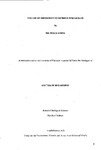THE USE OF PREBIOTICS TO IMPROVE FISH HEALTH
| dc.contributor.author | STONE, MICHELLE | |
| dc.contributor.other | Faculty of Science and Engineering | en_US |
| dc.date.accessioned | 2013-11-04T13:25:44Z | |
| dc.date.available | 2013-11-04T13:25:44Z | |
| dc.date.issued | 2005 | |
| dc.identifier | NOT AVAILABLE | en_US |
| dc.identifier.uri | http://hdl.handle.net/10026.1/2581 | |
| dc.description.abstract |
The aim of this project was to analyse critically the potential use of prebiotics in aquaculture. Initially, the intestinal microflora of rainbow trout, raised in the aquarium facilities at CEFAS, Weymouth, was investigated using both conventional bacteriological (culture, BiOLOG) and molecular (Restriction Fragment Length Polymorphism (RFLP), 16S rRNA gene sequencing) techniques. Dominant colony types were identified as Aeromonas sobria, Carnobacterium piscicola and Clostridium gasigenes. A series of in vitro growth curve studies was carried out using a selection of intestinal bacteria and known fish pathogens, to determine the ability of intestinal bacteria to utilise the potential prebiotic candidates inulin, lactulose and lactitol. Both inhibition and stimulation of the growth of certain bacteria was noted. Inulin and lactulose were top-dressed onto commercial trout pellets at levels of 1000mg/Kg and 100mg/Kg and fed to healthy rainbow trout to determine the effect in vivo. Using Terminal Restriction Fragment Length Polymorphism (tRFLP) analysis and RFLP analysis, inulin was shown to increase the growth of Aeromonas sobria and decrease the growth of Clostridium gasigenes in comparison to samples obtained from fish fed a control diet. Prebiotic supplemented feeds were both palatable and safe. To investigate the effect of feeding an inulin-supplemented diet on the susceptibility of Rainbow trout to Yersinia ruckeri a cohabitation challenge was performed. Relative percent survival at 55% positive control mortality (RPS55) was 47%. Chi²analysis showed that differences between the controls and fish fed a diet supplemented with both 100 and 10mg inulin /Kg pellet feed were significant suggesting that inulin can improve the survival of fish coming into contact with the pathogen Yersinia ruckeri. | en_US |
| dc.description.sponsorship | Centre for the Environment, Fisheries and Aquaculture Science (CEFAS) | en_US |
| dc.language.iso | en | en_US |
| dc.publisher | University of Plymouth | en_US |
| dc.title | THE USE OF PREBIOTICS TO IMPROVE FISH HEALTH | en_US |
| dc.type | Thesis | en_US |
| plymouth.version | Full version: final and full version as approved by the examiners at the time of the award of your degree | en_US |
| dc.identifier.doi | http://dx.doi.org/10.24382/1325 |
Files in this item
This item appears in the following Collection(s)
-
01 Research Theses Main Collection
Research Theses Main


